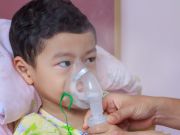Cough and fever most common initial symptoms; patchy lesions in lobules seen on chest CT in most patients
THURSDAY, June 18, 2020 (HealthDay News) — Clinical and epidemiological characteristics of pediatric severe acute respiratory syndrome coronavirus 2 (SARS-CoV-2) infections are described in an article published online June 16 in PLOS Medicine.
Che Zhang, from The First Affiliated Hospital of Xi’an Jiaotong University in China, and colleagues present the clinical and epidemiological characteristics of 34 pediatric patients with COVID-19 from four hospitals in a retrospective, observational study.
The researchers found that all patients presented with mild or moderate forms of COVID-19 (18 and 82 percent, respectively). Forty-eight percent of patients did not have a history of exposure to an identified source. Sixteen patients (47 percent) had mixed infections of other respiratory pathogens. Six patients had comorbidities. The most common initial symptoms were fever and cough (76 and 62 percent, respectively); expectoration, vomiting, and diarrhea were reported in 21, 12, and 12 percent, respectively. A substantial increase in serum amyloid A was reported in 85 percent of patients, while 59 percent had an increase in high-sensitivity C-reactive protein and 78 percent had a decrease in prealbumin. Eighty-two and 74 percent of patients had significant increases in the levels of lactate dehydrogenase and α-hydroxybutyrate dehydrogenase, respectively. In chest computed tomographic scans, patchy lesions in lobules were detected in 82 percent of patients; ground-glass opacities were rare (3 percent). Of the 32 patients with lesions in lobules, they still existed at discharge in 75 percent, although the main symptoms disappeared a few days after treatment.
“Our findings offer valuable insight into the early diagnosis and epidemic control of COVID-19 in children,” the authors write.
Copyright © 2020 HealthDay. All rights reserved.








